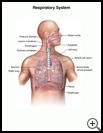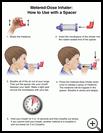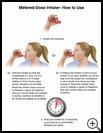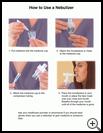
Chronic Obstructive Pulmonary Disease (COPD)
What is chronic obstructive pulmonary disease?
Small tubes called airways carry air in and out of your lungs. The airways branch into smaller and smaller tubes. At the end of each airway is a small sac that fills with air. The oxygen that you breathe in is transferred to your bloodstream through these air sacs. In healthy lungs, the airways are open and clear. The small sacs easily stretch like a balloon when you breathe in, and return to their smaller size when you breathe out.
Chronic Obstructive Pulmonary Disease (COPD) is a serious lung disease. Chronic means that the condition is life-long. Obstructive means that the airways are blocked by weakened or damaged lung tissue. Pulmonary refers to your lungs. There are two types of COPD:
- Chronic bronchitis: The muscles around the airways tighten up. Swelling, irritation, and sticky mucus block the airways, which makes it hard for you to breathe. This type of COPD causes mucous and coughing.
- Emphysema: Some of the air sacs in your lungs are destroyed, or they lose their ability to get bigger and smaller as air moves in and out. This makes it harder for your lungs to get oxygen into your blood. This type of COPD causes wheezing and shortness of breath.
Some people have both chronic bronchitis and emphysema.
COPD is usually caused by many years of smoking. Other possible causes are breathing in lots of secondhand smoke, air pollution, chemical fumes, or dust from your job, untreated asthma, and frequent lung infections. Some people have an inherited condition, called alpha tripsin deficiency, which can cause COPD.
What can I expect in the hospital?
You may need to stay in the hospital because:
- You are having a lot of trouble breathing
- Your oxygen level is very low
- You have a medical condition which is making your COPD symptoms worse
- Your COPD symptoms need immediate treatment or an adjustment to your treatment
Several things may be done while you are in the hospital to monitor, test, and treat your condition. They include:
Monitoring:
- You will be checked often by the hospital staff.
- Your blood oxygen level will be monitored by a sensor that is attached to your finger or earlobe.
- Your heart rate, blood pressure, and temperature will be checked regularly.
Testing:
Testing may include:
- Spirometry, which is a breathing test that measures how well you breathe in and out. You may be tested before and after taking medicine to see how your symptoms respond to medicine.
- X-rays of the chest and lungs to check for infections or other abnormalities
- Arterial blood gas (ABG), which is blood test to measure the levels of oxygen and carbon dioxide in your blood
- Sputum culture, a test in which fluid made in the lungs is tested to check for cancer cells or infections
- Bronchoscopy, which uses a flexible, lighted tube passed through your mouth and down into your lung to see abnormal areas. A biopsy may be taken to help make a diagnosis. A biopsy is the removal of a small sample of tissue for testing.
- Echocardiogram: Sound waves and their echoes are passed through your body from a small device that is held against your skin to create pictures of your heart, to see if lung problems have affected your heart.
Treatment:
The treatment for COPD depends on your symptoms, how quickly you get better with the treatments given, your overall health, and any complications you may have.
- You will be given oxygen through a small tube placed under your nose or through a mask placed over your face. In very severe cases, you may need a tube put into your lungs to help you breathe.
- You will have a small tube (IV catheter) inserted into a vein in your hand or arm. This will allow medicine to be given directly into your blood and to give you fluids, if needed.
- Your provider may prescribe medicines to:
- Relax and open the airways
- Reduce swelling in your lungs
- Loosen the mucus in your lungs and help you cough it up
- Treat or prevent an infection
- Make breathing easier
- Your provider may recommend other types of therapy to help relieve pain, other symptoms, or side effects of treatment.
- In rare cases of severe COPD, you may need surgery. Surgery may include:
- Lung volume reduction surgery (LVRS): Surgery to remove damaged parts of one or both lungs
- Lung transplantation: Surgery to remove a damaged lung and replace it with a lung from a donor
- Bullectomy: Surgery to remove tissues damaged by large air spaces in the lungs that interfere with breathing
What can I do to help?
- You will need to tell your healthcare team if you have new or worsening:
- Trouble talking or walking because of shortness of breath
- Bluish or gray color of your lips or fingernails
- Trouble breathing that does not get easier with medicine
- Fast breathing or trouble catching your breath
- Feeling like you are going to die
- Chest discomfort (pressure, fullness, squeezing or pain) that lasts more than a few minutes or goes away and comes back or chest discomfort that goes to your arms, neck, jaw or back
- Chest pain when you take a breath
- Coughing up mucus that is thick or blood-stained
- Ask questions about any medicine or treatment or information that you do not understand.
How long will I be in the hospital?
How long you stay in the hospital depends on many things, such as your general health, why you are in the hospital, the treatment you need, and how well you recover. Talk with your provider about how long your stay may be.
Last modified: 2016-04-19
Last reviewed: 2016-04-19




